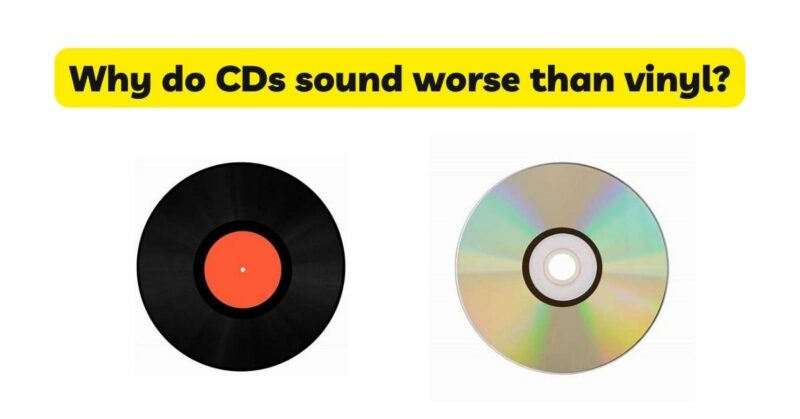The debate between CDs and vinyl records often sparks discussions about sound quality. Some enthusiasts argue that CDs sound worse than vinyl, attributing this perception to the analog nature and unique characteristics of vinyl records. However, it is essential to critically examine the factors that contribute to this perception and explore whether CDs truly sound inferior to vinyl. In this article, we will debunk the myth that CDs sound worse than vinyl and delve into the reasons behind this perception.
- Digital Sound Reproduction: CDs are a digital format, meaning they convert sound into a series of numerical values or samples. This digital representation allows for precise and accurate sound reproduction without the inherent imperfections associated with analog formats. CDs use a sampling rate of 44.1 kHz and a bit depth of 16 bits, which provide a high level of detail and dynamic range.
- Frequency Response and Dynamic Range: CDs offer a wide frequency response, capturing the entire audible range of human hearing (20 Hz – 20 kHz). This frequency response allows for faithful reproduction of the original recording, ensuring that no audible information is lost. Furthermore, CDs have a wide dynamic range, preserving the subtle nuances and variations in volume that are crucial for a realistic listening experience.
- Low Noise and Distortion: Digital formats like CDs have low levels of inherent noise and distortion. Unlike vinyl records, which can introduce surface noise, pops, and clicks, CDs provide a clean and noise-free listening experience. The absence of these distractions allows the listener to focus on the music without any sonic artifacts or interference.
- Consistency and Reproducibility: CDs offer consistency and reproducibility in sound quality. Once a CD is manufactured, every copy produced will sound identical to the original master. This uniformity ensures that listeners can enjoy the same sound quality across multiple copies, making CDs a reliable and consistent medium for music playback.
- Technological Advancements: Since the introduction of CDs in the early 1980s, significant technological advancements have been made in digital audio. These advancements have led to improved digital-to-analog conversion techniques, higher sampling rates, increased bit depths, and enhanced signal processing algorithms. Modern digital audio technology allows for highly accurate sound reproduction, rivaling the perceived warmth and character of vinyl records.
- Subjectivity and Listener Bias: Perceptions of sound quality are highly subjective and can be influenced by individual preferences and biases. The belief that vinyl sounds better than CDs may stem from the romanticization of vinyl’s analog nature, nostalgia for older recording techniques, or personal connections to vinyl records. Such biases can influence the perception of sound quality, leading some individuals to believe that vinyl inherently sounds better.
- Equipment Quality and Setup: The quality of the playback equipment and system setup can greatly impact the perceived sound quality of CDs. High-quality CD players, amplifiers, speakers, and proper system calibration are essential for achieving optimal sound reproduction. Investing in high-fidelity audio equipment and ensuring proper setup can maximize the potential of CDs and provide an exceptional listening experience.
- Mastering Techniques and Production Choices: The mastering process plays a crucial role in shaping the sound quality of both vinyl and CDs. Mastering engineers make adjustments to optimize the audio for each specific format, taking into account the unique characteristics and limitations of vinyl and digital formats. While mastering choices can vary, it is important to note that well-mastered CDs can provide a high level of sound quality and fidelity.
- Listening Environment and System Limitations: The listening environment and the limitations of the playback system can influence the perceived sound quality of CDs. Factors such as room acoustics, speaker placement, and ambient noise can impact the overall listening experience. Additionally, inferior or poorly calibrated audio equipmentcan introduce distortions or limitations that may affect the sound quality. It is essential to create an optimal listening environment and ensure the quality of the playback system to fully appreciate the capabilities of CDs.
Conclusion: The perception that CDs sound worse than vinyl is a subjective belief influenced by factors such as nostalgia, biases, and the romanticization of vinyl’s analog nature. In reality, CDs offer accurate sound reproduction, wide frequency response, low noise, and consistent quality. Technological advancements in digital audio have significantly improved the fidelity and realism of CDs, challenging the notion that vinyl inherently sounds better.While vinyl records possess unique characteristics and offer a different listening experience, it is important to recognize that sound quality preferences are subjective and vary from person to person. The choice between vinyl and CDs should be based on individual preferences, collecting goals, and the desired listening experience. Ultimately, both formats have their strengths and appeal, and the enjoyment of music should be the primary consideration when selecting a format. Embracing the diversity of formats can provide a well-rounded music collection that caters to different moods, preferences, and listening environments.


